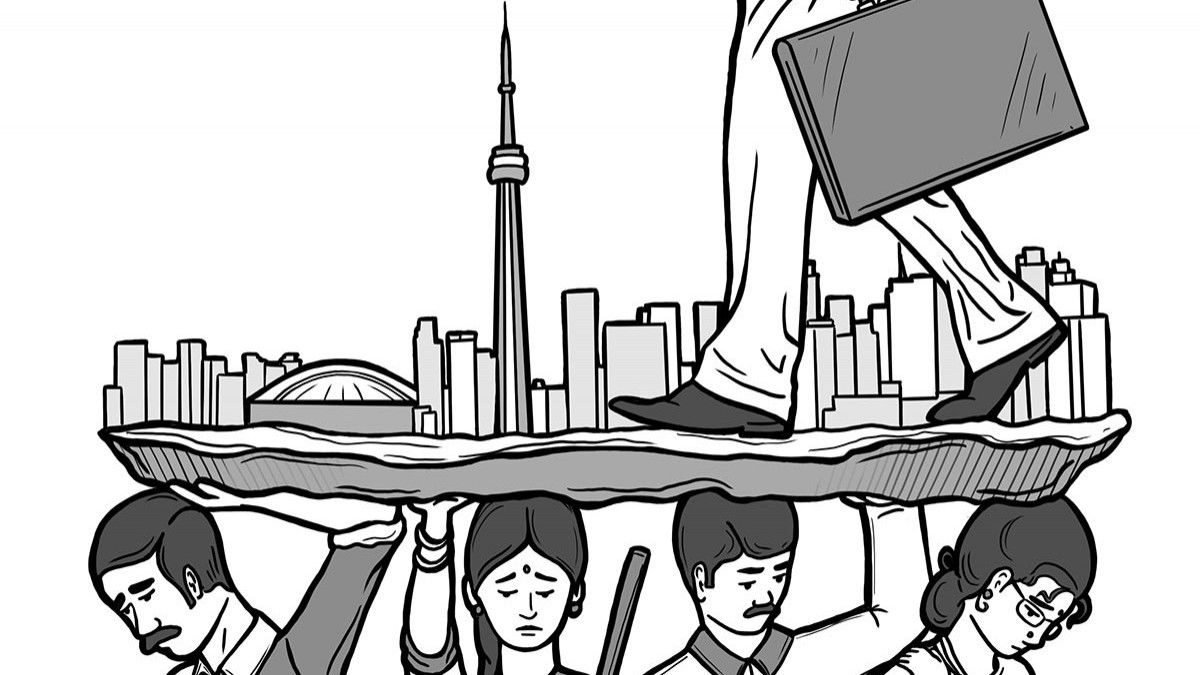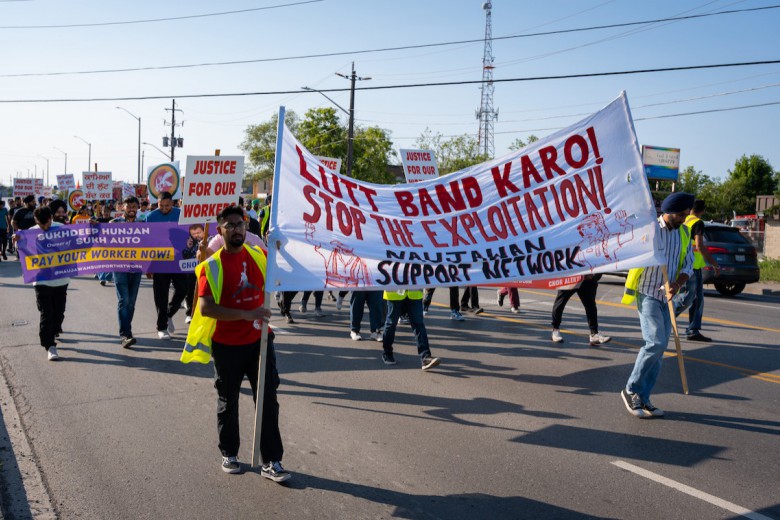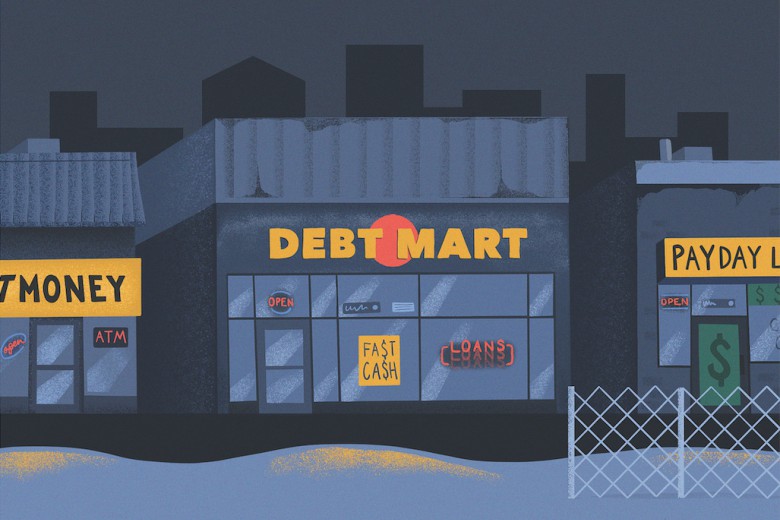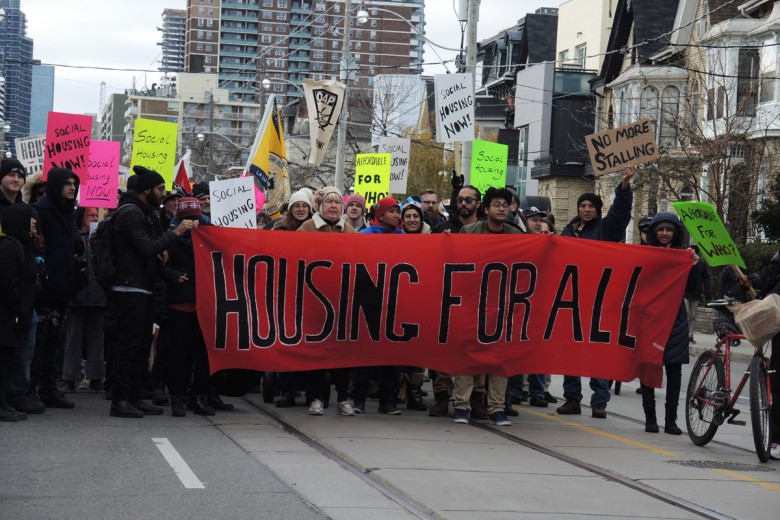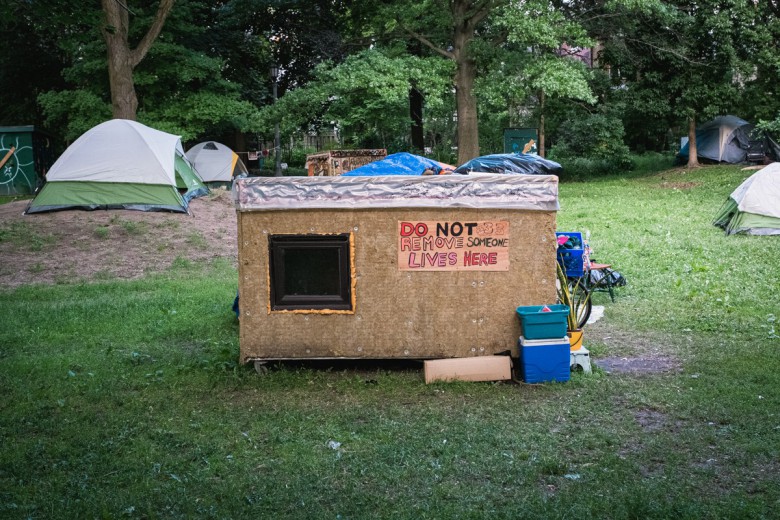Tamil people created, own, and manage the businesses woven tightly into the fabric of Toronto – Babu Take-Out & Catering, the famous Spiceland franchise – but we are also the workers stocking shelves, sweeping the aisles, weighing and cutting fish, and packing up hundreds of iddiyappams. The restaurant industry was one of the few industries in which Tamil migrants were initially able to find work – albeit often underpaid and exploitative work. Today, we are the working class as well as, increasingly, Toronto’s elite – but behind the wealth of the Tamil elite lies the fact that most of us arrived in Toronto fleeing genocide. Where once we sought shelter in the Nallur Kandaswamy temple in Jaffna, we fled to seek safety at the crosswalks of McCowan and Finch.
How we came to be
The Tamil genocide haunts the political activities of Toronto’s Tamil community; to understand Tamil diaspora politics today, we must first understand the events that began in 1948.
Tamil people are concentrated in the state of Tamil Nadu in the south of India and in the north and east of the island of Sri Lanka. Sri Lanka’s population is three-quarters ethnically Sinhalese (who are predominantly Buddhist) and 15 per cent Tamil (who are largely Hindu). After Sri Lanka gained independence from British colonization in 1948, the Sinhalese Buddhist majority – who formed government in 1956 – began discriminating against Tamils. In 1956, the government passed the Sinhala Only Act, making Sinhala the official language of Sri Lanka; in 1971, the Policy of Standardization made it so that Tamil students had to score higher than Sinhalese students to qualify to attend university; and in 1979, the government passed the Prevention of Terrorism Act, which allowed for the government to detain people – predominantly Tamils – without a warrant.
In 1956, the government passed the Sinhala Only Act, making Sinhala the official language of Sri Lanka.
In response, the Liberation Tigers of Tamil Eelam (LTTE, commonly known as the Tamil Tigers) formed as an armed resistance group seeking to create a sovereign state for Tamils in northern Sri Lanka. The armed conflict that erupted between the Tigers and the government in 1983 cost 40,000 lives, according to the United Nations (though other sources put the death toll as high as 100,000). The Sri Lankan government defeated the LTTE in 2009, ending the 26-year-long conflict.
In 1979, the government passed the Prevention of Terrorism Act, which allowed for the government to detain people – predominantly Tamils – without a warrant.
The first Tamils arrived in Canada long before the war, in the 1940s and 1950s. They were educated, wealthy, Westernized, and few in number. Harini Sivalingam, a lawyer and organizer in Toronto, tells me that prior to 1983, the Tamil community was predominantly composed of people on student visas who immigrated for better jobs and education. But as of 1983, Tamil refugees began fleeing the island in droves. Still, most of those who could leave – especially those who were able to flee with their whole family – were of higher caste and class. Canadian immigration policy was sympathetic, allowing most Tamil refugees to bypass stages of the refugee hearing process. Between 1989 and 1998, Tamil asylum claims to Canada had an acceptance rate of 85 per cent.
Still, most of those who could leave – especially those who were able to flee with their whole family – were of higher caste and class.
In the early days of Tamil migration to Canada, refugees faced violent white supremacy. In 1993, a 41-year-old Sri Lankan Tamil refugee and restaurant worker named Sivarajah Vinasithamby was left partially paralyzed after being attacked by a member of the white supremacist organization Heritage Front.
Sivalingam explains that, following the early 1990s, a third wave of Tamil migrants arrived in Canada, thanks to family reunification programs for refugees. Most of these migrants settled in Toronto and Montreal; today, Canada’s Tamil population officially numbers 157,000 – though experts agree that this number lowballs the Tamil population, since it doesn’t include the many Tamils who may be reluctant to identify themselves to census officials.
Policing and surveillance
The September 11, 2001, attacks and the subsequent “war on terror” changed the relationship between Canada and Tamil refugees: refugees began to be seen as a national security threat. In the years following 9/11, countries – including the U.K., Canada, and the entire European Union – would outlaw the LTTE and prohibit LTTE fundraising activities on their soil.
In 2001, a Globe and Mail headline screamed: “Bullets fly as Tamil gang war flares.” The piece highlighted AK Kannan and VVT, two gangs born and bred in Scarborough and Mississauga. In the 1990s an 2000s, the gangs were responsible for the deaths of a number of young tamil men – including 19-year-old Kapilan Palasanthiran, 19-year-old Annushath Indrakanthan, and 22-year-old Kristian Thanapalan. For some young Tamil men, the gangs served as a family at a time when Tamil families were fragmented across oceans and within the same homes because of intergenerational trauma. Gangs were also a source of protection: Tamil people experienced violent racism and held a mistrust of authority that was rooted in the violence they experienced at the hands of the Sri Lankan military during the war. Shortly after the death of Palasanthiran in 1997, a group of Tamil people established the Canadian Tamil Youth Development (CanTYD) Centre in Toronto. They aimed to prevent gang violence by providing Tamil youth with social supports and role models.
For some young Tamil men, the gangs served as a family at a time when Tamil families were fragmented across oceans and within the same homes because of intergenerational trauma.
In response to the mounting gang violence, Toronto police created the Tamil Task Force, committed to investigating Tamil youth and conducting surveillance of Tamils in Toronto. Sivalingam explains, “law enforcement did not understand that the increase in violence was a social problem and not necessarily a crime problem. These kids had a lot of social issues affecting them. Many youth didn’t have family supports and they were staying in Toronto with uncles because they themselves were refugees. If they did have family in Canada, there was a lack of communication and trust between family members. The youth also carried PTSD from a war-torn country.”
The decision to name the new police unit the “Tamil Task Force” heightened the stigma surrounding the Tamil community. A report by CanTYD, Toronto Tamil Youth: The Realities, recommended that “the name ‘Tamil Task Force’ needs to be eliminated for the term is offensive and counterproductive for improving relations with the police.” Sivalingam tells me that it was through the Tamil community’s advocacy that the Tamil Task Force was eventually renamed the Street Violence Task Force.
In 2001, a joint task force by Citizenship and Immigration Canada and the Toronto Police Service conducted a mass police raid called Project 1050, resulting in the arrest of 51 Tamil men believed to be members of VVT and AK Kannan. “The majority of the accused were charged under a section of the immigration act that prohibits involvement in a criminal organization, marking the first time street gangs were classified as ‘organized crime’ under immigration laws,” Michelle Shephard observed in the Toronto Star. Sivalingam explains that “many of the men who were deported as a result of Project 1050 had similar profiles: they came to Canada as youth in the early- to mid-1990s and got involved in minor street crimes such as assault, drug possession, fraud, etc. They got caught up in the 1050 sweeps which brought them under the radar of immigration enforcement. In some cases the deportations were still being fought years after. Some of the cases at the federal court are from 2012 which are more than 10 years after the raids.”
Those who were deported were sent back to a country in the midst of an ongoing war. Panchalingam Nagalingam, who was deported to Sri Lanka in 2005 following the 1050 raids, says he was kidnapped from his home in Colombo and tortured for two days.
Sivalingam tells me that it was through the Tamil community’s advocacy that the Tamil Task Force was eventually renamed the Street Violence Task Force.
This history helps explain the continued surveillance and racial profiling that Toronto police still deploy against Black and brown communities. In March 2020, the Toronto Police Service held a public town hall to discuss their proposed installation of CCTV cameras in Scarborough, Jane and Finch, and Chinatown – three neighbourhoods of mostly racialized residents. As Friends of Chinatown Toronto observed, “Heightened police surveillance will target poor + BIPOC folks – police surveillance does NOT equal safety.”
The 2009 Gardiner protests
One of the most pivotal moments in the formation of Tamil political identity in Canada was the Gardiner protests in Toronto, which occurred on Mother’s Day 2009. After months of smaller protests and hunger strikes beseeching the Canadian state to intervene in the Sri Lankan genocide, over 2,000 Tamil people walked out on to the Gardiner Expressway, bringing traffic to a standstill. Canada took notice. The mainstream media responded with naked racism. An inflammatory National Post article by George Jonas explained how “rabid Tamils surged into roadways blocking traffic, demanding Canada to save them, turning from figures of sympathy into bloody nuisances, from citizens into adversaries, from freedom fighters into extortionists.” Christie Blatchford complained in the Globe and Mail, “We live in a country where we don’t even know how many of our fellows are Tamils from Sri Lanka, but are simultaneously asked to accept on faith that they are properly and legally here and to extend to them every privilege conferred by Canadian citizenship.” Newspapers referred to protesters’ actions as “controversial,” their demeanour as “aggressive,” and their ideology and demands as indistinguishable from those of the LTTE.
Kiruthiha Kulendiren is a staff representative for the Canadian Office and Professional Employees Union and a Tamil-Canadian woman who joined the 2009 Gardiner protests. “Walking from Queen’s Park to the Gardiner happened organically,” she recalls. “It was a visual outpouring of intrinsic grief and the grief overflowed on the Gardiner and [coagulated] on Spadina.”
“The Tamils walked down Spadina to the Gardiner and we had nothing left – we were empty. All we had inside of us was grief. It wasn’t just a protest asking for justice. We were being erased,” she continues.
“It was a visual outpouring of intrinsic grief and the grief overflowed on the Gardiner and [coagulated] on Spadina.”
Then, in October 2009 and August 2010, two ships arrived on the coast of B.C. – the Ocean Lady and MV Sun Sea. Filled with 568 Tamil refugees fleeing genocide, the Canadian government chose to detain all the passengers. The adults were variously accepted as refugees, deported, or charged with human smuggling. Stephen Harper’s administration tabled Bill C-49, the Preventing Human Smugglers from Abusing Canada’s Immigration System Act, which was later incorporated into Bill C-4 and then C-31. Bill C-31 passed in 2012. The bill made it a criminal act for asylum seekers to come to Canada through “irregular” means. This specifically criminalized lower-caste and lower-class refugees. The Harper administration and the then-minister of public safety, Vic Toews, restricted refugees who arrived in Canada under the guise that the Canadian state was concerned about human smuggling and passengers’ links to terrorism.
I bring up some of the turmoil of Tamil people in the late ’90s and 2000s to showcase the shift in the Canadian government’s response to Tamil migrants and our struggle for liberation. When Tamil people needed Canadian state intervention the most, to stop the genocide, Canada failed the Tamil people. Instead, the government chose to criminalize, surveil, and dehumanize the Tamil people of Toronto.
The fallout from genocide
In 2020, we have mayoral acknowledgements of genocide, a Tamil Heritage Month, two Tamil MPPs, and a Tamil MP. Both MPPs are members of the Progressive Conservative (PC) Party of Ontario, and the MP is a member of the Liberal party. I asked members of my community why Tamil people are voting PC; they told me that the PC party chose Tamil men to represent predominantly Tamil ridings. Overwhelmingly, Tamil people are attracted to voting for Tamil men who look like them and are able to communicate with them in both Tamil and English. It remains somewhat radical for a Tamil person to hold political office – both because of racism in the Canadian electorate and because the Sinhala Only Act – which mandated that public servants speak Sinhalese – prevented Tamil people from working in the Sri Lankan government and forcibly retired existing Tamil public servants.
And even though Tamil people in Toronto remain sympathetic to the plight of refugees, Darshika Selvasivam, a Tamil activist in Toronto, tells me that Islamophobia, anti-Indigenous racism, and anti-Blackness persist throughout the community, making right-wing politics attractive to some.
Gender-based violence is a pervasive issue in the community – just last year, Tharshika Jeganathan was killed by her ex-husband on her way home from her job at Dollarama in Scarborough. In a 2008 study published in the journal Health Care for Women International, Tamil women said that intimate partner violence occurred as a result of “mental illness, anger and loss of control, infidelity, and binge drinking.” The study also found that Tamil women were held responsible for “provoking” their husbands’ violence. Alcoholism is also a noted issue in the community, though few statistics exist to corroborate what we all know, because many cases of family violence, mental illness, and trauma go undocumented and unspoken in the community. The trauma is intimately related to poverty in the community – trauma prevents people from keeping jobs, and poor physical health results in early deaths.
But for every model minority story, there are many more Tamil folks working the night shift for a poverty wage.
Today, some Tamil people have been able to invest in the capitalist myth of “pulling yourself up by your bootstraps” and use work to isolate their trauma – working multiple jobs, sleeping five hours a night, and saving vigorously. But for every model minority story, there are many more Tamil folks working the night shift for a poverty wage.
In 2018, four Tamil migrant workers from India spoke to CBC about the atrocious working conditions they say they faced as sculptors for the Sridurka Hindu temple in Richmond Hill. Sleeping in the bedbug-infested basement boiler room of the temple by night, by day they were allegedly drastically underpaid, underfed, and forced to work long hours in unsafe conditions without breaks. Two of the workers, Sekar Kurusamy and Suthakar Masilamani, claim the temple owes them over $66,000 in stolen wages. The temple has denied the allegations. The Tamil Workers Network raised awareness and sought legal recourse for the workers.
John No, a lawyer with Parkdale Community Legal Services, which took on the case for free, explained to CBC that temporary foreign workers’ “ability to stay in Canada and make a living is completely dependent on that one employer. So if that one employer is treating them badly, whether in terms of working conditions or employment standards, they have very little real recourse because they can’t leave that job.”
Tamil art and resistance today
At the same time, Toronto is blooming with Tamil art and organizing, and each sphere faces these issues head-on.
Nedra Rodrigo, a Tamil woman, created Tam Fam Lit Jam as a space to hear and present poetry written and performed by Tamil people. She is also spearheading the Tamil Community Centre (TCC) in Toronto, a space that includes recreational facilities, meeting rooms for community groups, and more. Though specific programming hasn’t yet been developed, surveys conducted by the TCC show a high demand for a gymnasium, an auditorium, mental health services, and space for a museum commemorating the Tamil genocide.
Thurka Gunaratnam is a Tamil comedian who created the New Normal Comedy Show for BIPOC, LGBTQ2S+, and women comedians. She hosts monthly shows in Toronto and Scarborough that aim to destigmatize sex and queerness in BIPOC communities.
The Workers Action Centre hosts $15 & Fairness, a campaign to increase Ontario’s minimum wage to $15 and fight for stronger workplace rights, like vacation time and overtime pay. Alongside Mandarin and English, Tamil is one of the languages into which the Workers Action Centre translates their materials. I spoke to Milan Nadarajah, an organizer with the centre, who explains that much of Toronto’s Tamil population still works unstable and precarious jobs. He spoke of how the first generation of Tamil migrants worked minimum-wage jobs in Toronto, while the second generation of Tamil people are working jobs with higher wages in fields like accounting or law.
The Service Employees International Union’s (SEIU’s) Justice for Janitors campaign is a movement of over 225,000 janitors across Canada and the United States – and since the launch of the Toronto campaign in 2007, 4,000 of those janitors are in Toronto. Many janitors in Toronto are racialized, and a high proportion are Tamil. Laxy Saunthararajan, a union organizer for SEIU Local 2, tells me that in the 1980s, janitorial contracts were given directly from property managers. But throughout the 1980s and into the 1990s, property managers began subcontracting; companies would enter bidding wars, with the lowest bidder receiving the contract. This drove down wages for janitors. Prior to unionization, contracts would be flipped frequently because property managers or building owners merely sought out companies who had lower bids – resulting in poor job security and inhumane wages. Justice for Janitors aims to get all subcontracting companies under one collective bargaining agreement.
Saunthararajan emphasizes that the purpose of Justice for Janitors is to empower janitors to build political power outside and within their workplaces. She tells me about a conversation she had with a Tamil janitor who was key in organizing his workplace around 2007 or 2008. When discussing what motivated him to organize his co-workers, he talked about the armed conflict back in Sri Lanka and how he struggled to make ends meet here. He said that he knew what it’s like to lose everything as a community, and that he wanted to ensure that his legacy will be one of improvement and change for the Tamil community.
Update, April 27, 2020: This article originally stated that Tam Fam Lit Jam is a venue for LGBTQ+ Tamil poets. It has been updated to reflect that, while many of the performers are LGBTQ+, all Tamil poets are welcome to perform.


